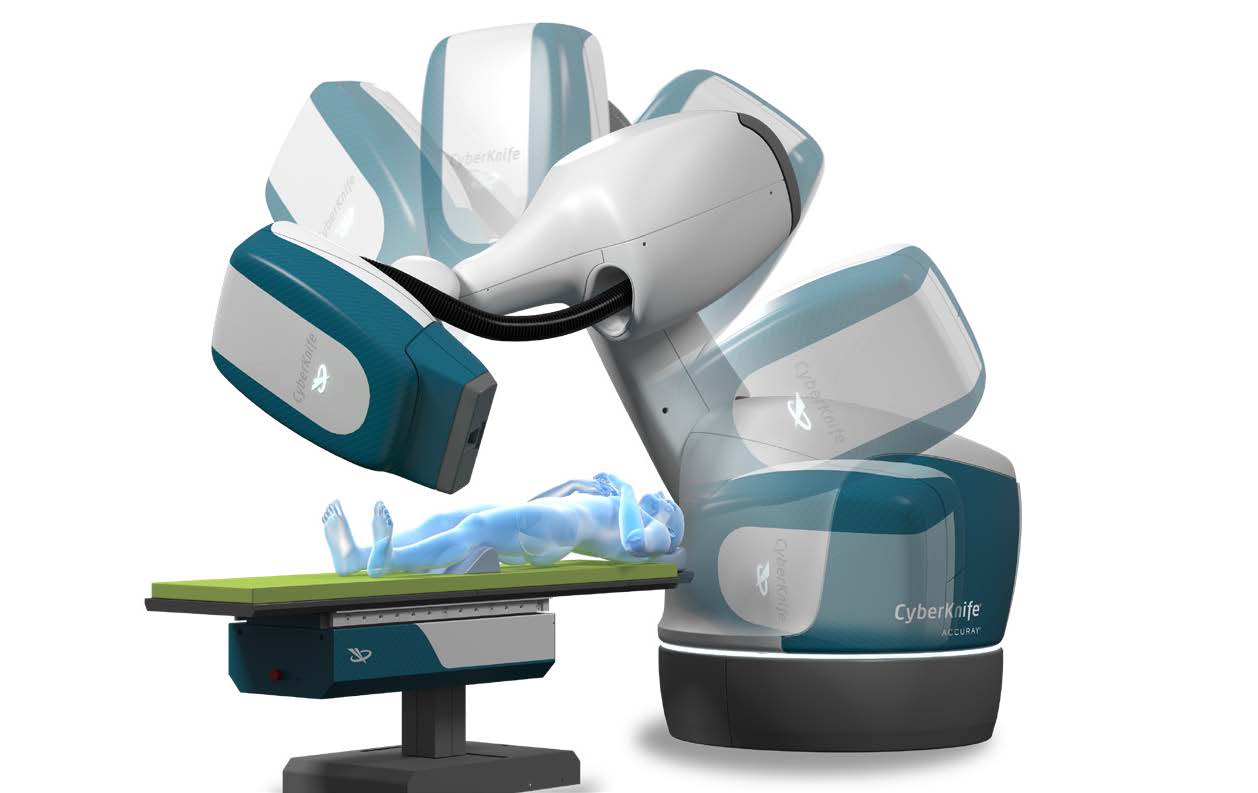Robotic Radiotherapy Could Improve Survival in Breast Cancer Patients
 A new study published in Frontiers in Oncology found early-stage breast cancer patients could experience significant improvements in survival if treated with accelerated partial breast irradiation (APBI) delivered using the Accuray CyberKnife robotic radiotherapy platform. Study investigators performed complex modeling that also indicates the survival rate could be better with CyberKnife APBI than other radiation delivery approaches, including volumetric-modulated arc therapy, three-dimensional conformal radiation therapy ABPI, and high dose rate brachytherapy.
A new study published in Frontiers in Oncology found early-stage breast cancer patients could experience significant improvements in survival if treated with accelerated partial breast irradiation (APBI) delivered using the Accuray CyberKnife robotic radiotherapy platform. Study investigators performed complex modeling that also indicates the survival rate could be better with CyberKnife APBI than other radiation delivery approaches, including volumetric-modulated arc therapy, three-dimensional conformal radiation therapy ABPI, and high dose rate brachytherapy.
Early-stage breast cancer treatment typically includes breast-conserving surgery followed by radiotherapy. The addition of radiotherapy can extend survival that may be offset by the development of a secondary cancer – like lung tumors – many years following treatment. Radiotherapy technology that has the ability to precisely deliver the prescribed radiation dose only to the target while minimizing dose to the surrounding healthy tissue is essential to reduce the incidence of secondary cancers.
“Important findings from this study of dynamic modeling using Real World Evidence (RWE) underscore the fact that we potentially can help to prevent unnecessary deaths related to radiation-induced secondary lung cancer associated with the treatment of early-stage breast cancer. Advanced radiotherapy techniques can decrease the dose to the lung delivered during breast cancer treatment with a probable reduction in risk of mortality,” said Frank A. Vicini, M.D., FACR, FASTRO, FABS, chief academic officer for Michigan Healthcare Professionals and national principal investigator at GenesisCare Oncology. “Our study shows that APBI delivered in 1-5 sessions, called ultra-hypofractionated APBI, using 4π robotic technology provides the most effective option with a potential reduction in the risk of mortality of over 85%.”
The CyberKnife platform, the first and only robotic radiotherapy platform, features a compact linear accelerator mounted on a highly maneuverable robotic arm that moves around the resting patient while delivering non-coplanar radiation beams from potentially thousands of unique angles, targeting only the tumor while minimizing radiation dose to healthy tissue. The CyberKnife platform is equipped with artificial intelligence (AI)-driven motion synchronization technology, Synchrony, that adjusts the radiation beam to the patient or tumor movement, allowing the patient to breathe freely while keeping precisely on target throughout the treatment, automatically. Together, the CyberKnife robotic design with Synchrony facilitates the delivery of ultra-hypofractionated APBI with extreme accuracy and precision, reducing patient burden.
“Accuray is leading the transformation of radiotherapy by partnering with our customers to develop technology and therapies that make a real difference in patients’ lives. This study reinforces the unparalleled accuracy of a 4π-like robotic CyberKnife platform and shows its tremendous potential as a treatment for early-stage breast cancer,” said Suzanne Winter, president at Accuray. “Secondary lung cancers most frequently occur two to three decades after radiation treatment for early-stage breast cancer, a significant issue for people with long life expectancies. The CyberKnife platform’s ability to deliver radiotherapy with sub-millimeter accuracy and precision is critical to the continuing health and well-being of these patients.”
The purpose of the study was to determine the risk of developing radiation-induced secondary lung cancer (SLC) in patients diagnosed with early-stage breast cancer and whether different radiotherapy techniques could save lives. An analysis of the SEER database, the Surveillance, Epidemiology, and End Results Program, from 1988 to 2012 identified 765,697 non-metastatic breast cancers of which 49.8% received radiotherapy and were included in the study. The number of SLCs was calculated using the BEIR model, measuring the health risks from exposure to low levels of ionizing radiation, modified with data from the SEER database. Breast cancer stage distribution and number of new cases were obtained from the North American Association of Central Cancer Registries (NAACCR). Mean lung dose for various irradiation techniques was obtained from measurement or literature. Jean-Philippe Pignol, M.D., Ph.D., chief medical & technology officer at Accuray and corresponding author of the Frontiers in Oncology paper, was chair of radiation oncology at Erasmus MC in Rotterdam, The Netherlands and Dalhousie University in Halifax, Canada when the study was conducted.